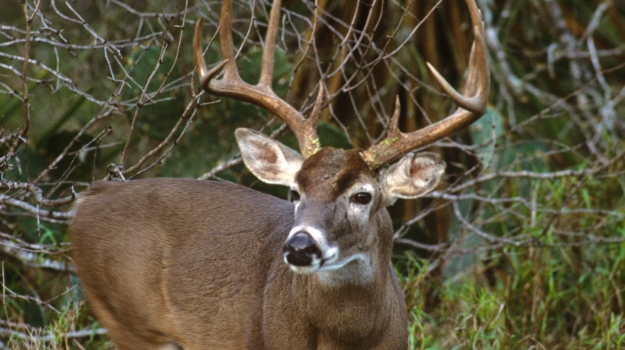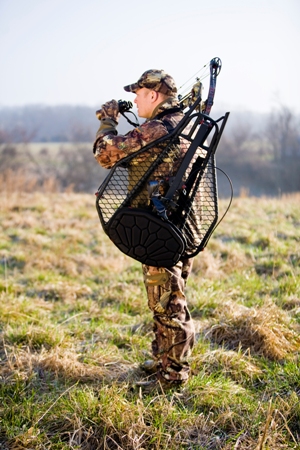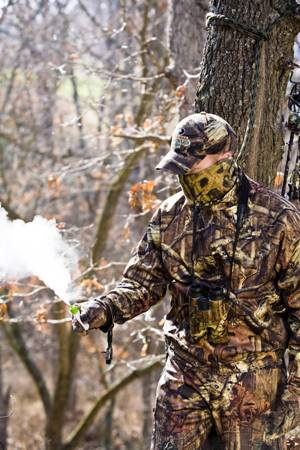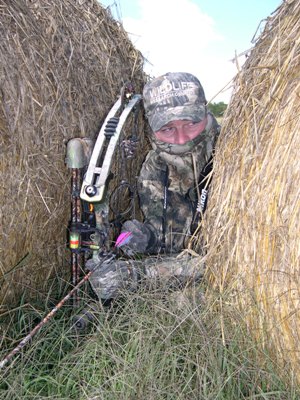
Keys to Selecting Whitetail Ambush Locations
By Todd Amenrud
Pink-light was breaking over the horizon as the critters in the Iowa timber began to wake around me. Perched in a treestand I could oversee eight huge, fresh scrapes from my vantage. I checked the wind before climbing into the tree and it seemed safe. Add the fact the “weather man” had predicted I should have perfect conditions all day for this spot and it all furthered my anticipation. However, puffing my “wind-checker” again made me very uneasy because I watched the particles float off exactly where I didn’t expect them to go... in the wrong direction – the route I expected “him” to approach from. I considered getting out of my set-up so as not to foul the area - but it was too late.
The remains of some crunchy snow let me know a deer was headed my way. The huge western Iowa 5x5 appeared over the top of the ridge, but because the thermals were now warming and rising, things had changed, at that moment he had the conditions in his favor. The thermal current sucking back up the ridge actually nullified the 5 to 8 MPH wind, and in fact, made the current flow back in the opposite direction. He walked towards me until he came upon one of those scrapes about eighteen yards away. With the thermal sucking my scent towards him I thought I better take the first opportunity that arose. I held at full draw until it felt like my arms were going to fall off. I’ve been religious about my scent control for many years. It was evident that I was either getting really lucky or Scent Killer in truth works because he was standing directly where I saw the particles float to when I checked. He finally turned to get a better vantage to work the “licking-branch” – now was my chance. I released and watched the buck topple over after a fifty yard dash.
 Out of all the avenues this buck could have taken in the middle of 2,000 acres of timber, why did he pick the route where I was waiting? More importantly, why did “I” choose that spot? Many hunters have questions about treestand placement. Every situation is different and there aren't any rules where there aren't exceptions to them. However, over the years I've learned some general practices that will help in most situations when placing a treestand.
Out of all the avenues this buck could have taken in the middle of 2,000 acres of timber, why did he pick the route where I was waiting? More importantly, why did “I” choose that spot? Many hunters have questions about treestand placement. Every situation is different and there aren't any rules where there aren't exceptions to them. However, over the years I've learned some general practices that will help in most situations when placing a treestand.
Proper herd management is essential if you want the best hunting possible, and learning how to make the most effective ambush set-ups will help you to be a more proficient gamekeeper.
I really learned my licks back 20 some years ago when I worked with an outfitter friend in southern Manitoba. With all the treestands I had to place out for clients, friends and the multitude of set-ups I made for myself, there were some years I set up 80 to 90 treestands. I had Popeye-like forearms from screwing in tree-steps and snipping shooting lanes, but I endured it because I’ve never seen hunting any better and it gave me the opportunity to learn a lot.
We have a number of factors that must be taken into account when choosing proper ambush locations. I say “ambush locations” because a ground blind can be every bit as effective as a treestand. When considering the best spot we need to contemplate seasonal patterns, topography and structure, wind and thermal current, direction of the sun, available cover and ease of access just to name a few. A great deal hinges on choosing the correct spot, let alone setting it up and concealing it properly.
Much of choosing the proper stand site has to do with “structure.” In the same way that an angler finds the “spot on the spot,” the lay of the land and the subtle differences that restrict or “guide” movement are keys to stand placement. As with most animals, whitetails travel from place to place using cover and terrain to their advantage. Learning to recognize the transition areas, access points, and travel corridors whitetails utilize is a key to stand placement.
One of the first things you should do when approaching a new spot is to obtain an aerial photo, topographical map, or now days the easiest way is to view the parcel on Google Maps. The first spots to focus on are the funnels. I don’t care if you’re hunting big timber, agricultural land or rural lots - there are funnels in your hunting area. Wherever you can restrict their movement to a smaller zone there is typically going to be more traffic. Also, if you can confine their movement to a smaller area it’s easier to position yourself to remain undetected from their “nose.”
When looking over an area I like to first imagine the terrain without any trees, brush or blow-downs. Look for the points, terrain breaks, steeper angles, edges or turns that will force or encourage the animal to go one way over another. If you try and foretell their travel patterns this way first, when you add the trees, brush and blow-downs back to the picture it can sometimes seem obvious where they will pass through.
I like to use cattle as an example to get this point across. If you put cattle into a new pasture and then come back one year later you will see well worn paths to and from wherever point A and point B might be. It may not be a straight line, but it will be the easiest course. Whitetails will also take the easiest route – the path of least resistance. So learning to recognize how animals use the subtle terrain changes will make selecting stand sites much easier and possibly obvious when you add in flora and potential man made obstructions to the picture.
We can actually influence whitetails to travel where we want by creating trails or blocking others. Around the beginning of August I will sometimes create my own trails by using a pruner or a weed-whacker. Mature bucks can often be found near the thickest, nastiest cover possible; however, when traveling through it they will almost always, unless spooked, travel the easiest route they can find – again, the path of least resistance. You can also use downed trees or hinge-cut trees to block routes and force them to go a certain direction.
Knowing a whitetail's number one defense is its extremely responsive sense of smell; to be consistently successful we must learn how to battle it effectively and maybe even use it to our advantage. Aside from reducing odors on our person and cutting down on the foreign odors we leave behind, we also need to understand how whitetails use the air currents to their advantage.
 Scent elimination is of extreme importance. We need to reduce the foreign odors that we carry into their domain to a minimum. Everything that I bring into the whitetail's domain will be treated to destroy smells at the molecular level with Scent Killer products.
Scent elimination is of extreme importance. We need to reduce the foreign odors that we carry into their domain to a minimum. Everything that I bring into the whitetail's domain will be treated to destroy smells at the molecular level with Scent Killer products.
Besides reducing offensive odors we also have to learn how to play the wind and thermal current, basically the “stream” that carries smells to a whitetail’s nose. You have to know how to place yourself within their terrain so you can “see them” before they “smell you.” Becoming skilled at reading air currents is also a secret into discovering “when” and “how” whitetails will utilize an area.
Everybody knows what the wind is, but many whitetail hunters east of the Mississippi don't pay enough attention to thermal current. The heating and cooling of the air combined with different temperatures emanating from various sources makes the air current do some weird things. Out west, because of the mountainous terrain most veteran hunters are familiar with thermal, but it's also extremely important in flat areas too. It could be as simple as paying attention to the sun’s direction when hunting a clearing or food plot. When the sun rises it shines on one side of the clearing first. The sun warms the air and the current rises on that side of the clearing before it does on the opposite side.
Pay particular attention around water, rocks, dark conifer trees or anything that may retain a temperature different than the air. When the temperatures differ, you'd be amazed at how the air current may be swirling around. Many times they look just like river currents and you can have eddies, dead spots or a whirlpool effect.
Many mediocre hunters lick their finger, stick it in the air, and point downwind to the spot where they'll place their treestand. Here’s where they fail - often the sign they are observing has been made under totally different conditions than the wind blowing that one specific direction. A whitetail is NOT going to spend a great deal of time in an area where it can't use its nose efficiently. A buck may never use that trail, or enter that area under those specific conditions.
You can't just set up downwind of an area and expect to have luck. My first thought about a spot is "under what conditions is a whitetail going to want to be in this area." I want a buck to be comfortable with the chosen site, but also under the conditions that I want to hunt the site. Then, set up downwind or cross-wind. I guess what I'm trying to say is, "you need to play how a whitetail plays the wind.”
My best advice is to purchase some sort of a “dust-puffer” or un-scented cotton. With some way to detect the flow you can actually watch how the air current is flowing and how scent will be carried to a deer. Aside from this being a great tool to physically play the wind, when you actually see the air currents you begin to understand some of the secrets of deer movement.
Mapping wind directions will help you to choose locations. The wind directions given to us on various media weather outlets are just generalizations for the area. With timber edges, land formations, water bodies and the topography of an area a slight variation in wind direction can mean the world. A south wind on the Weather Channel can be an east or west wind once you get to your hunting location. If the speed is right different influences like a blocking tree-line or a mountain can obstruct the current and guide it a particular way. Again, a “wind-checker” of some kind is necessary to really begin to see and understand these currents. When combining the wind mapping with known bedding areas and feeding areas you can more accurately predict where they’re going to be and where they will likely travel.
Once you find a good spot, I suggest setting up multiple stand locations so that you can play different wind directions and conditions. At a given time I may have as many six or eight different stand locations just to pursue one specific buck. This way you won’t burn a stand and ruin your chances of killing a mature buck simply because you hunted when you shouldn’t have…when the conditions weren’t in your favor.
Seasonal needs will change a whitetail’s patterns. Scouting will tell you where you will need to be to take advantage of them. Trail cameras are the best piece of technology to hit our industry in the past twenty years. The info gathered with these, combined with glassing and reading sign will tell you where you need to be. Typically a spot closer to a feeding location is safer in terms of “totally bumping the buck and ruining the hunt.” But a spot closer to a bedding area gives you a better chance for a shot during legal hunting hours.
If you’re setting up near a food plot you must be very careful. Setting up right on the plot can be the kiss of death. If one animal busts you getting down out of that treestand I would bet you just ruined your chance of killing a mature buck out of that tree for the entire season. You need to be VERY sneaky when it comes to mature bucks. Often it is best to set up just off of the plot so you can make sure that you can access and leave the site without being detected if there are deer in the plot.
Having a variety of crops in your “hunting plots” is important if you wish to have the potential of hunting the site all season long. Ideally, if you have the space, you should have a palatable food choice that will keep them coming to the plot from before bow season begins until the end of the season, or until the food runs out. If you have a small plot you’ll have to choose a planting that will be at the peak of its attraction when you plan on using it as a “magnet.”
 Simple, common sense details like direction of the sun and available background cover also come into play. Do you like to look into the sun? Well neither does a whitetail. In fact, we have a UV filter in our eye and a whitetail lacks this filter, so they REALLY don’t like to look into the sun. Use this to your advantage. Try to be “up-sun” from where you believe they will be. Wind direction trumps all else, but if you have a choice this can be one more “arrow in your quiver” – pun intended.
Simple, common sense details like direction of the sun and available background cover also come into play. Do you like to look into the sun? Well neither does a whitetail. In fact, we have a UV filter in our eye and a whitetail lacks this filter, so they REALLY don’t like to look into the sun. Use this to your advantage. Try to be “up-sun” from where you believe they will be. Wind direction trumps all else, but if you have a choice this can be one more “arrow in your quiver” – pun intended.
How high do you place your treestand is an often pondered preference. Much has to do with available cover and how close you believe you’ll be to the deer. As an example, a treestand is better placed higher in a bald poplar tree with no cover than a bushy red oak. You want to look like anything but a human silhouette, so available cover in the tree or something to break up your human form is an important consideration.
I must also mention ground blinds. In recent years I’ve harvested more mature bucks out of a ground blind than a treestand…I guess simply because I’ve been using one more, but there are some advantages to each – in a treestand I can see further, my movement is concealed somewhat because of the elevation, and most importantly my scent isn’t concentrated on the same level as their nose. On the other hand, a ground blind can be placed basically anywhere, even in a spot without any trees. My movement is concealed inside the blind and my scent is somewhat contained in the blind. The one main thing with a blind is it needs to be concealed and “brushed-in” VERY well. Otherwise you’ll need to set it up well in advance of the hunt so your herd becomes accustomed to it…or both. With a turkey you can pop up a blind in the middle of an open field and they’ll come strutting right up to it ten minutes later…not so with a whitetail. You need to make it as inconspicuous as possible.
More bucks are harvested each year while hunting from treestands than by any other method, but don’t overlook the option of a ground blind. If you take the topography and structure into consideration combined with the wind and thermal when selecting your ambush locations, it will help you to harvest more deer, bigger bucks and maybe that trophy of a lifetime.






























